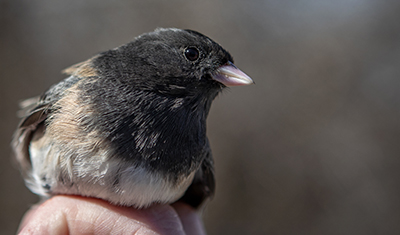WSU Student Researchers Investigate Utah’s Bird Population
OGDEN, Utah – Weber State University students are gaining hands-on experience in avian research through an ongoing study of bird populations near the university’s Ogden campus; they will present the research at WSU’s Undergraduate Research Symposium, held virtually, April 13.
 The research team also hopes eventually to conduct similar research on birds during a trip to Lake Baikal in Russia.
The research team also hopes eventually to conduct similar research on birds during a trip to Lake Baikal in Russia.
The avian research near the WSU campus began in the fall 2019 semester when John Cavitt, zoology professor, led students to set up a bird banding station in the foothills east of Stewart Stadium.
Using a technique called mark recapture, Cavitt and his team captured birds in nets, before placing small numbered bands on their legs and releasing them, hoping to determine populations by the number recaptured over time. Additionally, the team assessed the birds’ physiological conditions, looking for signs of diseases and viruses. This 60-second YouTube video allows viewers to see the researchers at work.
Recently, a study in the journal “Science” reported bird populations in North America have declined more than a 25% over the past 50 years. Cavitt and his team will use data they collect and compare it to the research of former WSU ornithologist Carl Marti who recorded bird populations in the 1970s. This will allow WSU researchers to determine if our area is experiencing a noticeable decline.
“We have captured over 400 individual birds,” Cavitt said.
.jpg) Cavitt, along with College of Science Dean Andrea Easter-Pilcher, hope to lead students on a trip to conduct related research at Lake Baikal in Russia’s Siberia region. Originally scheduled May 15-31, the trip was postponed to help prevent the spread of COVID-19. Cavitt and Easter-Pilcher are now planning to reschedule.
Cavitt, along with College of Science Dean Andrea Easter-Pilcher, hope to lead students on a trip to conduct related research at Lake Baikal in Russia’s Siberia region. Originally scheduled May 15-31, the trip was postponed to help prevent the spread of COVID-19. Cavitt and Easter-Pilcher are now planning to reschedule.
While researchers are disappointed by the trip’s delay, they have gained a passion for Utah’s bird species over the spring semester.
“When you hold them up close, you really get to see the differences between birds, and the differences between males and females,” said Sydney Toolson, WSU lab technician and zoology graduate, who has assisted Cavitt and worked alongside the students.
Toolson and others worked with more than a dozen species during the semester. She especially enjoyed working with woodpeckers. “Their coloration is really pretty, and they’re feisty. They always make a lot of noise,” she said.
Laura Judd, zoology major, said she wasn’t interested in ornithology before taking Cavitt’s ornithology class and conducting research with him on shore birds last summer. Now, she’s working on the research near campus and hopes to visit Russia with the study abroad team.
“It’s something I’ve actually really loved,” she said. “I have more appreciation for birds and everything they bring to the ecosystem.”
Cavitt plans to continue the research in coming years to gain more robust data before publishing results. Judd and Toolson, along with zoology major Bryce Cowan, will present on aspects of the study at the Undergraduate Research Symposium. Find more details at weber.edu/oursymposium.
For photos and video, visit the following links.
wsuucomm.smugmug.com/Colleges-and-Departments/Science-College-of-Science/Bird-Banding
Visit weber.edu/wsutoday for more news about Weber State University.
Jaime Winston, Marketing & Communications
801-626-7396 • jaimewinston@weber.edu- Contact:
John Cavitt, zoology professor
801-626-6172 • jcavitt@weber.edu